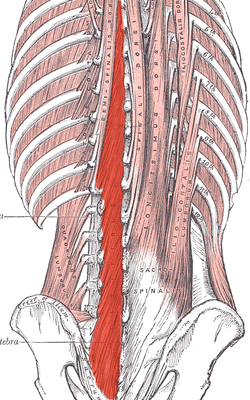| Multifidus muscle | |
|---|---|
 Deep muscles of the back. (Multifidus shaded in red.) | |
 Sacrum, dorsal surface. (Multifidus attachment outlined in red.) | |
| Details | |
| Origin | Sacrum, erector spinae aponeurosis, PSIS, and iliac crest |
| Insertion | Spinous process |
| Nerve | Posterior branches |
| Actions | Provides proprioceptive feedback and input due to high muscle spindle density; Bilateral backward extension, unilateral ipsilateral side-bending and contralateral rotation. |
| Identifiers | |
| Latin | musculus multifidus spinae |
| TA98 | A04.3.02.202 |
| TA2 | 2276 |
| FMA | 22827 |
| Anatomical terms of muscle | |
The multifidus (multifidus spinae; pl.: multifidi) muscle consists of a number of fleshy and tendinous fasciculi, which fill up the groove on either side of the spinous processes of the vertebrae, from the sacrum to the axis. While very thin, the multifidus muscle plays an important role in stabilizing the joints within the spine. The multifidus is one of the transversospinales.
Located just superficially to the spine itself, the multifidus muscle spans three joint segments and works to stabilize these joints at each level.
The stiffness and stability makes each vertebra work more effectively, and reduces the degeneration of the joint structures caused by friction from normal physical activity.
These fasciculi arise:
- in the sacral region: from the back of the sacrum, as low as the fourth sacral foramen, from the aponeurosis of origin of the sacrospinalis, from the medial surface of the posterior superior iliac spine, and from the posterior sacroiliac ligaments.
- in the lumbar region: from all the mamillary processes.
- in the thoracic region: from all the transverse processes.
- in the cervical region: from the articular processes of the lower four vertebrae.
Each fasciculus, passing obliquely upward and medially, is inserted into the whole length of the spinous process of one of the vertebræ above.
These fasciculi vary in length: the most superficial, the longest, pass from one vertebra to the third or fourth above; those next in order run from one vertebra to the second or third above; while the deepest connect two adjacent vertebrae.
The multifidus lies deep relative to the spinal erectors, transverse abdominis, abdominal internal oblique muscle and abdominal external oblique muscle.